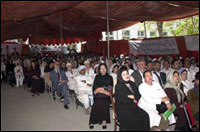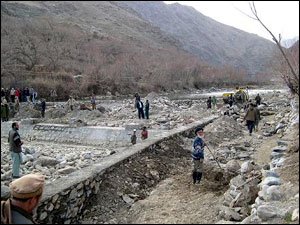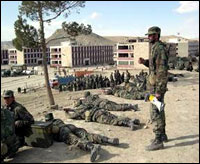
- Afghanistan
- Africa
- Budget Management
- Defense
- Economy
- Education
- Energy
- Environment
- Global Diplomacy
- Health Care
- Homeland Security
- Immigration
- International Trade
- Iraq
- Judicial Nominations
- Middle East
- National Security
- Veterans
|
Home >
News & Policies >
May 2003
|
For Immediate Release
May 19, 2003
Rebuilding Afghanistan
The United States and Afghanistan share a common vision for an Afghanistan that is prosperous, democratic, self-governing, and respectful of human rights. The determination of the Afghan people and the on-going commitment of the Coalition Partners have created an environment of stability and success. The U.S. has contributed over $900 million in assistance to the people of Afghanistan since 2001.
 Health
Health
Afghanistan has improved its health care system and with a U.S
commitment of $133 million planned for a three-year program, access to
health services will be expanded. Successes since April 2002
include:
- Reopening Rabia Balkhi Women's Hospital in Kabul, Afghanistan, after a six-month renovation project supported by the U.S. Departments of Health and Human Services (HHS) and Defense
- Vaccination of 4.3 million children against measles and treated 700,000 cases of malaria
- Revitalization of the polio eradication programs surveillance system
- Revising the national curriculum for midwives
- Completing the rebuilding of 72 hospitals, clinics and womens healthcare centers
- Planning to build or rehabilitate 550 heath care centers
| |||
Education
Afghanistan has made great strides in revitalizing the education
system. Recent successes include:
 4 million children are now enrolled in school
4 million children are now enrolled in school
- Six students completed the first module of a six-month radio journalism program offered by Radio Free Europe/Radio Free Liberty in Kabul
- Eleven men and six women graduated from the University of Kabuls new Cisco Networking Academy
- Afghan staff were hired and trained to work at Radio Arman, Afghanistans new independent radio station
Refugees
 The Afghan government and international organizations are assisting
the returning refugees. 2.5 million Afghans have returned home, the
largest refugee repatriation in the world in the last 30 years.
The Afghan government and international organizations are assisting
the returning refugees. 2.5 million Afghans have returned home, the
largest refugee repatriation in the world in the last 30 years.
The U.S. has helped with a total of $185.5 million since the beginning of the Afghan crisis in September 2001.
Agriculture
 Rehabilitating agriculture is key to the growth of the Afghan
economy and the local farmers are working to re-establish production.
The U.S. is helping by providing the following:
Rehabilitating agriculture is key to the growth of the Afghan
economy and the local farmers are working to re-establish production.
The U.S. is helping by providing the following:
- $6 million to assist the Afghan people in managing the water system
- $15 million to restore irrigation systems and other essential services
- 6,100 water projects (including wells, springs, irrigation canals, urban water systems, dams, and culverts)
Infrastructure
A priority for revitalizing the economy of Afghanistan is to
rebuild Afghans main transportation artery the Kabul-Kandahar-Herat
road
- The U.S. has committed $180 million to the rebuilding of the road The Kabul-Kandahar portion will be completed by the end of December 2003
- The U.S. in partnership with Norway will provide $12 million to build a bridge over the river between Afghanistan and Tajikistan
|
|||
Empowering Women
 Afghanistan is providing renewed opportunities for women. With the
support of the U.S., women are receiving education, skills and tools
they need to obtain jobs and integrate into the political and public
life. Programs include:
Afghanistan is providing renewed opportunities for women. With the
support of the U.S., women are receiving education, skills and tools
they need to obtain jobs and integrate into the political and public
life. Programs include:
- Handicraft training
- Resource centers that includes a library, Internet room and audio visual training centers
- Widow bakeries providing bread to Afghanistans urban poor
- Educational and vocational courses
Afghan National Army
The Afghan government plans to create an army of 70,000 to defend
their country. As of April 5, 2003 the ninth battalion of 716 Army
recruits began basic training.
The new recruits will be trained by fellow Afghan non-commissioned officers, instead of by Coalition Partners.
|
|||


 While waiting with his son outside the clinic, Nasser said of the Americans, "They are here, they are welcome, and they would help us rebuild our country, and we are grateful for that".
While waiting with his son outside the clinic, Nasser said of the Americans, "They are here, they are welcome, and they would help us rebuild our country, and we are grateful for that". President Bush welcomes the start of construction on the Kabul-Kandahar-Herat highway, Afghanistan's main transportation artery. The U.S.-Japanese-Saudi Arabian-Afghan partnership to build this road is part of a comprehensive, multi-billion dollar international reconstruction effort for Afghanistan. The road is a tangible example of the long-term commitment of the international community to Afghanistan.
President Bush welcomes the start of construction on the Kabul-Kandahar-Herat highway, Afghanistan's main transportation artery. The U.S.-Japanese-Saudi Arabian-Afghan partnership to build this road is part of a comprehensive, multi-billion dollar international reconstruction effort for Afghanistan. The road is a tangible example of the long-term commitment of the international community to Afghanistan.
 "We're very hopeful and at the same time very thankful that the coalition supports us and will continue to do so without ethnic or linguistic divisions, so that this national army will be able to rebuild the country for a brighter future," said Aziz Ullah, who is now a sergeant with 120 men under his command"
"We're very hopeful and at the same time very thankful that the coalition supports us and will continue to do so without ethnic or linguistic divisions, so that this national army will be able to rebuild the country for a brighter future," said Aziz Ullah, who is now a sergeant with 120 men under his command"